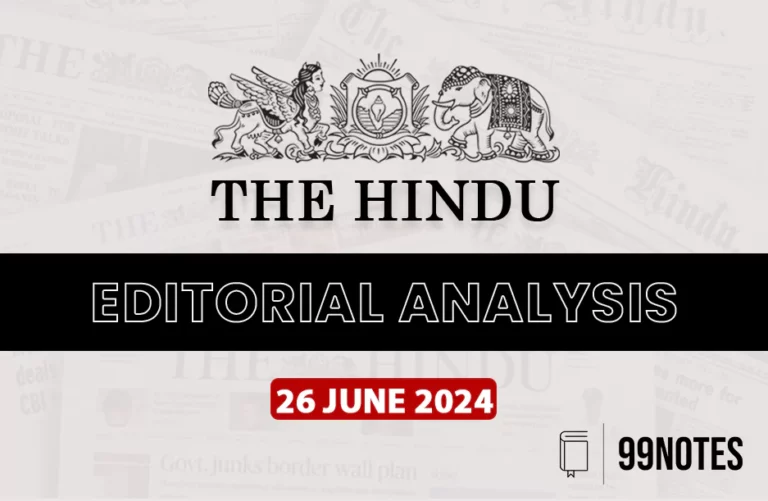2 March 2024 : The Hindu Editorial Notes PDF
The Hindu Editorial
2-March-2024
1. Change and continuity in India’s Palestine policy
| Topic: GS2 – International Relations The article is crucial for UPSC aspirants, offering insights into India’s diplomatic strategy, geopolitical considerations, and evolving Middle East dynamics. |
| Context |
| ● The article discusses India’s evolving stance on the Israel-Palestine conflict, examining the historical context, government’s position, diplomatic shifts, and the impact on regional dynamics. |
India’s Historical Position on Palestine:
- India historically supported the Palestine cause, even during the flourishing relationship with Israel in the past three decades.
- Maintained a careful balance between the new partnership with Israel and the historical commitment to Palestine.
Prime Minister Narendra Modi’s Response:
- After the October 7 Hamas attack in Israel, Prime Minister Narendra Modi expressed solidarity with Israel, stating he was “deeply shocked by the news of the terrorist attack.”
- Modi’s visit to Israel in 2017 and his good personal chemistry with Prime Minister Benjamin Netanyahu indicate a positive rapport.
Evolution of India’s Palestine Policy:
- India’s Palestine policy evolved from initially voting against the partition of Palestine in 1947 to recognizing Israel in 1950 but stopping short of establishing full diplomatic relations.
- India maintained support for a two-state solution, with Palestine having East Jerusalem as its capital and borders based on the 1967 lines.
India’s Evolving Position under Prime Minister Modi:
- Modi’s visit to Ramallah in 2018 indicated a shift, calling for dialogue without explicitly addressing the status of Jerusalem or borders.
- Realpolitik seems to displace the moral content of India’s Palestine policy under current government.
Post-October 7 Changes:
- Analysis suggests India’s position of balancing between moral criticism and support for Israel has not shifted drastically.
- India voted for resolutions condemning Israeli settlements, expressing concern over the occupation of Golan Heights, and supporting a Palestinian right to self-determination.
India’s Interests and Considerations:
- India’s support for the Palestine cause, even if limited, is rooted in tangible national interests.
- The ongoing humanitarian tragedy in Gaza, strong reactions in the Global South against Israel, and India’s aspiration to lead the Global South contribute to its stance.
Strategic Implications and Regional Dynamics:
- The October 7 attack and Israel’s retaliatory war have affected India’s strategic plans in the region.
- Further Arab-Israel reconciliation is on hold, impacting India’s cooperation with the Arabs, Israelis, and Americans.
India’s Diplomatic Statements:
- External Affairs Minister S. Jaishankar criticized Israel at the Munich Security Conference, stating that Israel “should be mindful of civilian casualties in Gaza.”
- India emphasizes the importance of an immediate end to the war, restoration of order, and a permanent resolution to the Palestine question for stability in West Asia.
Conclusion:
- India’s approach to the Palestine-Israel conflict reflects a nuanced stance, considering strategic, diplomatic, and regional factors.
- Balancing historical commitments, evolving diplomatic dynamics, and national interests guide India’s position in the complex geopolitical landscape of the Middle East.
| PYQ: India’s relations with Israel have, of late, acquired a depth and diversity, which cannot be rolled back.” Discuss. (150 words/10m) (UPSC CSE (M) GS-2 2018) |
| Practice Question: Discuss India’s evolving stance on the Israel-Palestine conflict and its strategic implications, considering diplomatic shifts and regional dynamics (150 words/10 m) |
2. India’s burgeoning death penalty crisis
| Topic: GS2 – Indian Polity – Judiciary Crucial for UPSC as it explores the surge in India’s death row, Supreme Court’s reform attempts, and systemic issues in sentencing. |
| Context |
| ● The article discusses the surge in India’s death row population, the Supreme Court’s efforts to reform death penalty sentencing, and the increasing number of acquittals, revealing systemic failures. |
Rising Death Row Population:
- India’s death row population reached a record high of 561 by the end of 2023.
- Supreme Court acquitted nearly 55% of death row prisoners in 2023, raising questions about the efficacy of death penalty sentencing.
Supreme Court’s Sentencing Reform Attempts:
- In 2022, a Constitution Bench was convened to reform death penalty sentencing, indicating an initiative for change.
- However, data reveals that trial courts continued to impose death sentences without following the directives from the Supreme Court.
High Court Reluctance and Acquittals:
- High Courts showed reluctance in confirming death sentences, with only one confirmation in 2023.
- Supreme Court’s acquittals of death row prisoners highlight systemic failures in police, prosecution, and trial courts.
Systemic Failures in Death Penalty Cases:
- Acquittals were outcomes of fabricated evidence, manipulated reports, tampered forensic evidence, and dubious recoveries by the police.
- Systemic problems within the administration of the death penalty were not acknowledged in the Court’s decisions.
Urgency for Systemic Recognition:
- Growing number of acquittals emphasizes the urgent need to recognize systemic problems in the criminal justice system.
- While the Court has addressed systemic concerns in sentencing, acquittals underscore broader issues in the death penalty administration.
State of Death Row Prisoners:
- Death row prisoners live in constant fear, subjected to violence, ridicule, and humiliation within prisons.
- Psychological ramifications persist even after acquittal or commutation, revealing the severe impact of the death row experience.
Increasing Death Row Population:
- Despite acquittals, the death row population continues to rise due to trial courts’ unjustifiable use of the death penalty.
- Project 39A’s report highlights a 15% decrease in High Court case disposal rate, exacerbating the crisis.
Supreme Court’s Response:
- The Supreme Court’s convening of a Constitution Bench is commendable but may be ineffective in addressing the death penalty crisis.
- Reform efforts focused on sentencing fail to percolate to trial courts, indicating the limited impact of such initiatives.
Dissonance in Supreme Court’s Approach:
- Project 39A’s report suggests a dissonance between the narrow sentencing question prioritized by the Court and the broader crisis across the criminal process.
- The Court’s reform efforts may be insufficient and untimely in addressing the systemic issues in death penalty cases.
| Case For And Against – Death Penalty |
Case FOR the Death Penalty
Case AGAINST the Death Penalty
|
| PYQ: Instances of President’s delay in commuting death sentences has come under public debate as denial of justice. Should there be a time limit specified for the President to accept/reject such petitions? Analyse. (200 words/12.5m) (UPSC CSE (M) GS-2 2014) |
| Practice Question: Examine the challenges and systemic failures in India’s death penalty administration, considering the Supreme Court’s reform initiatives and the rising death row population. (150 words/10 m) |
For Enquiry

2 March 2024 : The Hindu Editorial Notes PDF

2 March 2024 : PIB Summary for UPSC

2 March 2024 : Indian Express Editorial Analysis

1 Mar 2024 : Daily Current Affairs Quiz

1 Mar 2024 : Daily Answer Writing

1 March 2024 : PIB Summary for UPSC

1 March 2024 : Daily Current Affairs

1 March 2024 : The Hindu Editorial Notes PDF

1 March 2024 : Indian Express Editorial Analysis

29 Feb 2024 : Daily Current Affairs Quiz
March – The Hindu Editorial 2 March 2024 : The Hindu Editorial Notes PDF The Hindu Editorial
1-March-2024
1. E-evidence, new criminal law, its implementation
Topic: GS2…
PIB 2 March 2024 : PIB Summary for UPSC PIB Summary for UPSC
2-March -2024
1. INDIA – MALAYSIA BILATERAL MARITIME EXERCISE SAMUDRA LAKSAMANA
Topic:…
Indian Express 2 March 2024 : Indian Express Editorial Analysis Indian Express Editorial Analysis
2-March-2024
1. Blue water power
Topic: GS2 – International Relations…
Daily Quiz 1 Mar 2024 : Daily Current Affairs Quiz 1 Mar 2024 : Daily Quiz…
mains answer writing 1 Mar 2024 : Daily Answer Writing Mains Answer Writing
1-March-2024
Q1) Simultaneous elections can promote governance continuity and reduce…
PIB 1 March 2024 : PIB Summary for UPSC PIB Summary for UPSC
1-March -2024
1. Cabinet approves establishment of International Big Cat Alliance…
Daily Current Affairs 1 March 2024 : Daily Current Affairs Daily Current Affairs
1-March -2024- Top News of the Day
1. India Bolsters Strategic Presence in Indian…
March – The Hindu Editorial 1 March 2024 : The Hindu Editorial Notes PDF The Hindu Editorial
1-March-2024
1. E-evidence, new criminal law, its implementation
Topic: GS2…
Indian Express 1 March 2024 : Indian Express Editorial Analysis Indian Express Editorial Analysis
1-March-2024
1. HOW TO REDUCE CHEATING
Topic: GS2 – Social Justice…
Daily Quiz 29 Feb 2024 : Daily Current Affairs Quiz 29 Feb 2024 : Daily Quiz…





